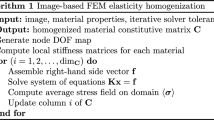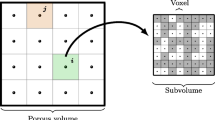Abstract
X-ray tomography techniques give researchers the full access to material inner structures. With such ample information, employing numerical simulation on real material images becomes more and more common. Material behavior, especially, of heterogeneous materials, e.g. polycrystalline, composite, can be observed at the microscopic scale with the computed tomography (CT) techniques. In this work, an efficient strategy is proposed to carry out simulations on large 3D CT images. A proposed matrix free type finite element based MultiGrid method is applied to improve convergence speed and to reduce memory space requirements. Homogenization techniques are used to obtain specific operators to enhance the convergence of the MultiGrid method when large material property variations are present. Hybrid parallel computing is implemented for memory space and computing time reasons. Free edge effects in a laminate composite with more than 16 billion degrees of freedom and crack opening in a cast iron are studied using the proposed strategy.





















Similar content being viewed by others
References
Alcouffe R, Brandt A, Dendy J Jr, Painter J (1981) The multi-grid method for the diffusion equation with strongly discontinuous coefficients. SIAM J Sci Stat Comput 2(4):430–454
Arbenz P, van Lenthe GH, Mennel U, Müller R, Sala M (2008) A scalable multi-level preconditioner for matrix-free \(\mu \)-finite element analysis of human bone structures. Int J Numer Methods Eng 73(7):927–947
Augarde C, Ramage A, Staudacher J (2006) An element-based displacement preconditioner for linear elasticity problems. Comput Struct 84(31–32):2306–2315
Benveniste Y (1987) A new approach to the application of Mori-Tanaka’s theory in composite materials. Mech Mater 6(2):147–157
Bessho M, Ohnishi I, Matsuyama J, Matsumoto T, Imai K, Nakamura K (2007) Prediction of strength and strain of the proximal femur by a CT-based finite element method. J Biomech 40(8):1745–1753
Boffy H, Baietto M-C, Sainsot P, Lubrecht AA (2012) An efficient 3d model of heterogeneous materials for elastic contact applications using multigrid methods. J Tribol 134(2):021401
Boffy H, Venner CH (2014) Multigrid solution of the 3d stress field in strongly heterogeneous materials. Tribol Int 74:121–129
Brandt A (1973) Multi-level adaptive technique (MLAT) for fast numerical solution to boundary value problems. In: Proceedings of the third international conference on numerical methods in fluid mechanics. Springer, pp 82–89
Brandt A (1977) Multi-level adaptive solutions to boundary-value problems. Math Comput 31(138):333–390
Carey GF, Jiang B-N (1986) Element-by-element linear and nonlinear solution schemes. Commun Appl Numer Methods 2(2):145–153
Ferrant M, Warfield SK, Guttmann CR, Mulkern RV, Jolesz FA, Kikinis R (1999) 3d image matching using a finite element based elastic deformation model. In: International conference on medical image computing and computer-assisted intervention. Springer, pp 202–209
Gu H, Réthoré J, Baietto M-C, Sainsot P, Lecomte-Grosbras P, Venner CH, Lubrecht AA (2016) An efficient multigrid solver for the 3d simulation of composite materials. Comput Mater Sci 112:230–237
Hashin Z (1979) Analysis of properties of fiber composites with anisotropic constituents. J Appl Mech 46(3):543–550
Hoekema R, Venner K, Struijk JJ, Holsheimer J (1998) Multigrid solution of the potential field in modeling electrical nerve stimulation. Comput Biomed Res 31(5):348–362
Hughes TJ, Ferencz RM, Hallquist JO (1987) Large-scale vectorized implicit calculations in solid mechanics on a cray X-MP/48 utilizing ebe preconditioned conjugate gradients. Comput Methods Appl Mech Eng 61(2):215–248
Kronbichler M, Ljungkvist K (2019) Multigrid for matrix-free high-order finite element computations on graphics processors. ACM Trans Parallel Comput (TOPC) 6(1):1–32
Lecomte-Grosbras P, Paluch B, Brieu M, De Saxcé G, Sabatier L (2009) Interlaminar shear strain measurement on angle-ply laminate free edge using digital image correlation. Compos A Appl Sci Manuf 40(12):1911–1920
Lecomte-Grosbras P, Réthoré J, Limodin N, Witz J-F, Brieu M (2015) Three-dimensional investigation of free-edge effects in laminate composites using X-ray tomography and digital volume correlation. Exp Mech 55(1):301–311
Lengsfeld M, Schmitt J, Alter P, Kaminsky J, Leppek R (1998) Comparison of geometry-based and CT voxel-based finite element modelling and experimental validation. Med Eng Phys 20(7):515–522
Liu X, Réthoré J, Baietto M-C, Sainsot P, Lubrecht AA (2019) An efficient strategy for large scale 3d simulation of heterogeneous materials to predict effective thermal conductivity. Comput Mater Sci 166:265–275
Michailidis N, Stergioudi F, Omar H, Tsipas D (2010) An image-based reconstruction of the 3d geometry of an al open-cell foam and fem modeling of the material response. Mech Mater 42(2):142–147
Mori T, Tanaka K (1973) Average stress in matrix and average elastic energy of materials with misfitting inclusions. Acta Metall 21(5):571–574
Moulinec H, Suquet P (1995) A FFT-based numerical method for computing the mechanical properties of composites from images of their microstructures. In: IUTAM symposium on microstructure-property interactions in composite materials. Springer, pp 235–246
Nguyen T-T, Rethore J, Yvonnet J, Baietto M-C (2017) Multi-phase-field modeling of anisotropic crack propagation for polycrystalline materials. Comput Mech 60(2):289–314
Özdemir I, Brekelmans W, Geers M (2008) Computational homogenization for heat conduction in heterogeneous solids. Int J Numer Methods Eng 73(2):185–204
Pipes RB, Pagano N (1994) Interlaminar stresses in composite laminates under uniform axial extension. In: Reddy JN (ed) Mechanics of composite materials. Springer, Dordrecht, pp 234–245
Proudhon H, Li J, Wang F, Roos A, Chiaruttini V, Forest S (2016) 3d simulation of short fatigue crack propagation by finite element crystal plasticity and remeshing. Int J Fatigue 82:238–246
Rannou J, Limodin N, Réthoré J, Gravouil A, Ludwig W, Baïetto-Dubourg M-C, Buffiere J-Y, Combescure A, Hild F, Roux S (2010) Three dimensional experimental and numerical multiscale analysis of a fatigue crack. Comput Methods Appl Mech Eng 199(21–22):1307–1325
Tezduyar T, Aliabadi S, Behr M, Johnson A, Mittal S (1993) Parallel finite-element computation of 3d flows. Computer 26(10):27–36
van Rietbergen B, Weinans H, Huiskes R, Polman B (1996) Computational strategies for iterative solutions of large fem applications employing voxel data. Int J Numer Methods Eng 39(16):2743–2767
Venner CH, Lubrecht AA (2000) Multi-level methods in lubrication. Elsevier, Amsterdam
Watremetz B, Baietto-Dubourg M, Lubrecht A (2007) 2d thermo-mechanical contact simulations in a functionally graded material: a multigrid-based approach. Tribol Int 40(5):754–762
Acknowledgements
We gratefully thank for the support of Région Pays de la Loire and Nantes Métropole through a Grant Connect Talent IDS.
Author information
Authors and Affiliations
Corresponding author
Additional information
Publisher's Note
Springer Nature remains neutral with regard to jurisdictional claims in published maps and institutional affiliations.
Appendix
Appendix
The following Eshelby’s tensor is for the spherical inclusion of a linear elastic problem in macroscopically isotropic materials.
where \(\nu \) is the Poisson’s ratio of the inclusion.
Rights and permissions
About this article
Cite this article
Liu, X., Réthoré, J., Baietto, MC. et al. An efficient finite element based multigrid method for simulations of the mechanical behavior of heterogeneous materials using CT images. Comput Mech 66, 1427–1441 (2020). https://doi.org/10.1007/s00466-020-01909-y
Received:
Accepted:
Published:
Issue Date:
DOI: https://doi.org/10.1007/s00466-020-01909-y




